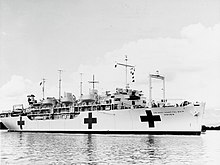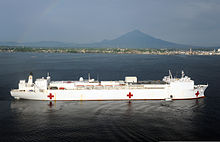The United States Navy, United States Coast Guard, and United States National Oceanic and Atmospheric Administration (NOAA) use a hull classification symbol to identify their ships by type and by individual ship within a type. The system is analogous to the pennant number system that the Royal Navy and other European and Commonwealth navies use.

The Comfort-class hospital ships were a United States Navy World War II-era hospital ship design. Three vessels were built using these specifications. All ships were constructed in 1943 by the Consolidated Steel Corporation before being decommissioned in 1946.

USS Pinkney (APH-2) was a Tryon-class evacuation transport that was assigned to the U.S. Navy during World War II. Pinkney served in the Pacific Ocean theatre of operations and returned home safely post-war with six battle stars but missing 18 crew members who were killed in action.

The General G. O. Squier class of transport ships was built for the U.S. Navy during World War II. The class was based upon the Maritime Commission's Type C4 ship. The class was named for United States Army Major General George Owen Squier.

BRP Miguel Malvar (PS-19) is the lead ship of the Malvar class of corvettes of the Philippine Navy. She was originally built as USS Brattleboro PCE(R)-852, a PCE(R)-848-class rescue patrol craft escort for the United States Navy during World War II. In 1966 she was transferred to South Vietnam for service in the Republic of Vietnam Navy as RVNS Ngọc Hồi (HQ-12). She was acquired by the Philippine Navy in April 1976 and later on commissioned as Miguel Malvar after Miguel Malvar y Carpio.

Austal Limited is an Australian-based global ship building company and defence prime contractor that specialises in the design, construction and support of defence and commercial vessels. Austal's product range includes naval vessels, high-speed ferries, and supply or crew transfer vessels for offshore windfarms and oil and gas platforms.

The Type C4-class ship were the largest cargo ships built by the United States Maritime Commission (MARCOM) during World War II. The design was originally developed for the American-Hawaiian Lines in 1941, but in late 1941 the plans were taken over by the MARCOM.

The Spearhead-class expeditionary fast transport (EPF) is a United States Navy–led shipbuilding program to provide a high-speed, shallow draft vessel intended for rapid intra-theater transport of medium-sized cargo payloads. The EPFs can reach speeds of 35–45 knots, and allow the rapid transit and deployment of conventional or special forces, equipment and supplies.

USNS Millinocket (JHSV-3/T-EPF-3)(ex-Fortitude) is the third Spearhead-class expeditionary fast transport, which is operated by the United States Navy's Military Sealift Command and was built in Mobile, Alabama.

The PCE-842-class patrol craft escort was a United States Navy (USN) ship class of submarine chasers designed during World War II. The PCE-842-class was the only class ever designated by the USN as the "patrol craft escort" (PCE) type. The PCE design was derived from the 180-foot (55 m) Admirable-class minesweeper to complement the 173-foot (53 m) PC-461-class submarine chasers that were used for anti-submarine warfare (ASW) in coastal areas. At 185 feet long and 640 tons, the PCE is more than twice the displacement of the PC but with a less powerful engine also much slower; however, because of its larger size, the PCE was able to undertake longer-range tasks over PC-461-class vessels. The USN envisaged the PCE as enabling PCs and smaller vessels to undertake coastal patrols without being called-upon as often to perform open ocean and convoy escort duties, while simultaneously freeing-up some larger vessels - such as destroyer escorts and destroyers - from convoy ASW duties. The PCE-482-class had a standard crew complement of 99 officers and men. The class would ultimately see 68 total vessels built, serving with multiple navies around the world.

USNS Brunswick (JHVS-6/T-EPF-6), is the sixth Spearhead-class expeditionary fast transport, currently in service with the United States Navy's Military Sealift Command. It is the fourth ship in naval service named after Brunswick, Georgia. Brunswick is one of three expeditionary fast transport ships in the U.S. 7th Fleet area of responsibility to continue its mission of providing rapid intra-theater transport of troops and military equipment. Like other EPFs of its class, the Brunswick is capable of carrying up to 600 short tons of equipment for distances of 1,200 nautical miles at an average speed of 35 knots.

The Type B ship is a United States Maritime Administration (MARAD) designation for World War II barges. Barges are very low cost to build, operate and move. Barges were needed to move large bulky cargo. A tug boat, some classed as Type V ships, could move a barge, then depart and move on to the next task. That meant the barge did not have to be rushed to be unloaded or loaded. Toward the end of World War 2, some ships that had not been completed in time for the war were converted to barges. US Navy barges are given the prefix: YWN or YW. Due to shortage of steel during World War II, concrete ship constructors were given contracts to build concrete barges, with ferrocement and given the prefix YO, YOG, YOGN. Built in 1944 and 1945, some were named after chemical elements.

USS Rockville (EPCER-851), also named USS PCE(R)-851, PCER-851 and ARC San Andres, was a PCE-842-class patrol craft of the United States Navy, Colombian Navy, and Columbian Coast Guard. Throughout her service, she served as a hospital ship, survey ship, evacuation ship, and research ship between 1943 and 1986.

USNS Bethesda (T-EMS-1) will be the seventeenth overall Spearhead-class expeditionary fast transport, and first of her Expeditionary Medical Ship class, operated by the United States Navy's Military Sealift Command. On 15 May 2023, Secretary of the Navy Carlos Del Toro announced that the ship would be named after the Bethesda Medical Center, now part of the Walter Reed National Military Medical Center, in Bethesda, Maryland. She will be the first ship in the US Navy to carry the name.

USNS Balboa (T-EMS-2) will be the eighteenth overall Spearhead-class expeditionary fast transport, and second Bethesda-class expeditionary medical ship. She will be operated by the United States Navy's Military Sealift Command.
















